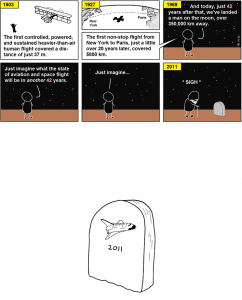It looks like the Pioneer anomaly may have been explained.
The Pioneer anomaly is the observed fact that Pioneer 10 and 11 are decelerating as they fly away from the Sun by an amount that is very, very slightly more than you’d expect from good old F = ma. The size of the anomaly is incredibly tiny — less than 10-9 m/s2. It seems incredible that such a small effect is even measurable, but over long times even very tiny effects add up. According to Wikipedia (I haven’t checked their numbers, but they’re always right about this sort of thing),
If the positions of the spacecraft are predicted one year in advance based on measured velocity and known forces (mostly gravity), they are actually found to be some 400 km closer to the sun at the end of the year.
That 400 km is due to the anomalous acceleration.
Some people hypothesized that this effect might be due to some new force, or to a deviation of the gravitational force from standard physics. The latter idea fits in with the idea, held by some physicists, that the phenomena of dark energy and (possibly) dark matter are actually signs that we don’t understand gravity.
But when an effect is so tiny, it’s very hard to be sure that there’s not some more mundane cause. The recent analysis, which is accepted for publication in Physical Review Letters, seems to point toward a mundane source.
The most plausible mundane explanation is that energy is being radiated away by the radioisotope thermal generators. That energy wouldn’t exert any net force on the craft if it were radiated equally in all directions, but if some of it is bouncing off of the craft (specifically, a big antenna), then there would be a net force.
As I understand it, the recent analysis shows that the acceleration is decaying away with time in the way you’d expect if this explanation is correct. Previous analyses had suggested the acceleration was constant in time, which was regarded as evidence against the mundane explanation.
I always thought it was pretty unlikely that the Pioneer anomaly was evidence of exotic new physics, so this doesn’t surprise me too much. It’d be nice if it were pointing us toward some revolutionary new theory, but such things don’t come along very often.
